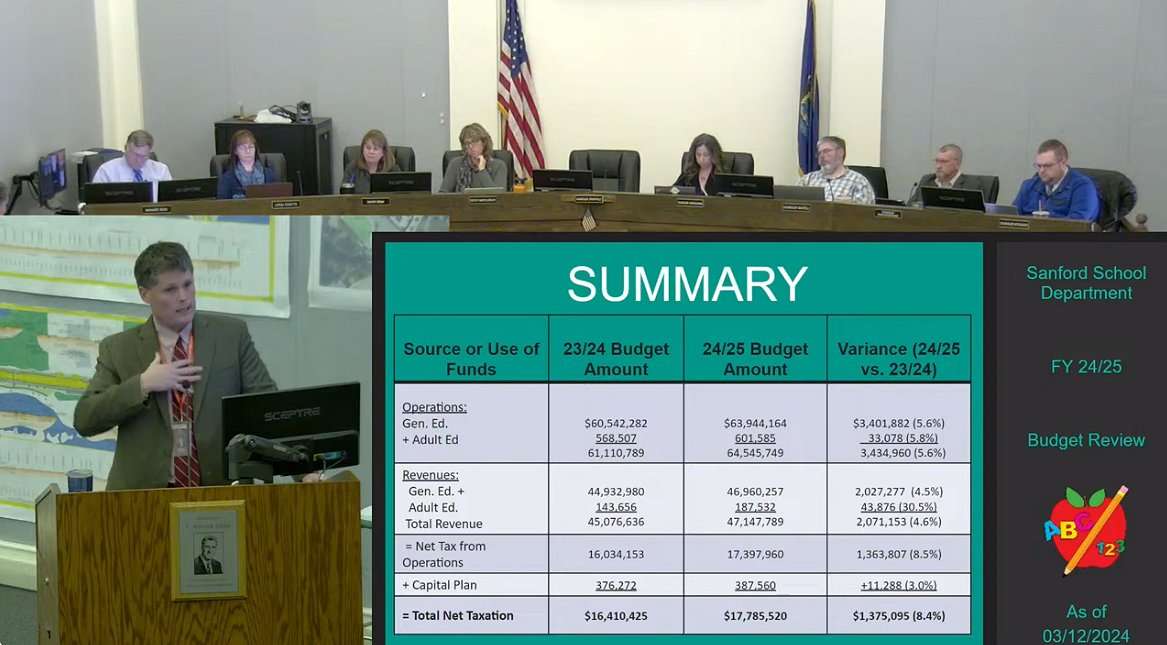Big School Budget Cuts Proposed, but Council Wants More
- March 15th 2024
- City NewsSchool News

Superintendent of Schools Matt Nelson summarizes his budget presentation to the City Council.
Source: WSSR-TV
By Zendelle Bouchard
Sanford’s Superintendent of Schools Matt Nelson is proposing to make hundreds of thousands of dollars in additional cuts to the school budget following input from School Committee members and City Councilors who pushed for the reductions.
The Committee met at a budget workshop on Monday, March 11, 2024, where Nelson presented four tiers of possible cuts. The exact details of the four tiers were not shared with members of the public in attendance, as the employees whose jobs might be eliminated were not given advance notice.
Nelson announced that Harvard Pilgrim Health had made an offer to reduce their planned 17.5% rate increase to 15% if the School Department agreed not to put the contract out to bid. This would save over $165,000 just in that single line item. He indicated that further negotiation could potentially produce even more savings. The School Department also anticipates saving more than $20,000 in electricity costs thanks to a new contract which will take effect in November.
The Tier I option would have reduced the tax impact from an 11.1% increase to 9.9% and involved restructuring of some central office staff and elimination of the First Team field hockey expenses. The Tier 2 option included moving a custodial position to cover a current opening, reorganizing accounts payable and shifting some ESSER funding to cover the salary and benefits of a middle school counseling position. This option would bring the tax impact down to 8.4%.
Nelson recommended the Committee discuss the Tier 1 and 2 cuts, and possibly Tier 3. He reminded them that the City Council indicated they were unhappy with the 11.1% increase but did not reach consensus on a percentage they would approve. He recommended the Committee not eliminate the Alternative Education program at Sanford High School this year but said instead he would like to see it transition to something more financially sustainable for the future.
The Committee members present each weighed in with their thoughts. (Chair Paula Cote was absent.) Jen Davie expressed her concern about some community members’ ability to absorb a significant tax increase, saying it would lead to more homelessness, child neglect and the elderly unable to meet basic needs. She didn’t name a specific figure she would approve but indicated it would have to include significant cuts.
Melissa Simpson reminded those present that the additional positions added to the budget with federal ESSER funds during the pandemic were supposed to go away once the pandemic was over, but many remain in the proposed budget, including the elementary school social workers. She said she would like to see the number of social workers reduced, arguing that the attention from social workers led some students to act out in class to get that attention and created disruptions for other students.
Vice Chair Amy Sevigny said it was “unrealistic and unfair” to consider the Tier 4 cuts and said cutting counseling and social work positions would lead to increased behavior problems. Emily Sheffield agreed that the social worker positions were needed to preserve the learning environment in the classroom. She said that eliminating the Alt Ed program along with the Tier 1 and 2 cuts, and adding back the SMS counselor position would bring the budget to a figure that might be more acceptable.
At the regular School Committee meeting which followed the budget work session, a number of school employees and members of the public spoke to advocate for continued support for counseling and social work services and the Alt Ed program. See that story for more details.
At the City Council meeting the following night, Nelson went through his presentation of the budget from the previous week in greater detail before outlining his proposed reductions based on Tier 1 and 2 cuts and other adjustments. He explained that the ESSER positions being added to the local budget this year were needed to meet the School Department’s priorities. He said while taxpayers were expecting all those positions to go away, he balanced them by taking other positions out of the local budget.
He showed a chart of per-pupil spending comparing Sanford to other school districts. At $13,502.78, Sanford is well below the state average of $16,426.89 and even further below the York County average of $17,480.51. Sanford spends the least amount per pupil of any district in York County. He said he is proud of the fact that Sanford does a good job educating its students for less money.
The proposed reductions from his previous presentation to the Council total $450,379. In addition to the health insurance and electricity savings, the reorganization of the central office and maintenance staff saves more than $107,000 and the removal of the SMS counselor position would save almost $75,000. He also explained that, because the ESSER positions are funded through the end of September, the last month of funding for the positions that are being eliminated can be transferred to the local budget to save an additional $75,000. Replacing the First Team field hockey program with a First Team volleyball program, which has greater interest from students, will save more than $6,000.
In summary, Nelson said the cuts and adjustments he made with input from the School Committee reduce the operations expense increase to 5.6%, with the net-to-taxation increase reduced from 11.1% to 8.4%. He noted that three of the Committee members still feel that 8.4% is too much, but he is tasked with meeting the needs of all 3,228 Sanford students enrolled in Pre-K through grade 12, including those with learning disabilities, medical needs and crippling anxiety, as well as the advanced placement and gifted students. “All students matter and every adult is important,” he said. He said he was advocating for the proper resources “to do what I feel is the most important work there is.” He said any further cuts would involve the elimination of programs, and he didn’t want to pit those against each other, but “if we have to, we will.”
In response to questions from the Council, Nelson explained the difference between the work done by school counselors, who are responsible for all students, and the work done by social workers, who are trained to do much more intensive work with specific students who have mental health or other needs. He encouraged Councilors to watch the public comments from the previous night’s School Committee meeting for a more detailed explanation.
Mayor Becky Brink thanked Nelson for his passionate defense of the budget and pointed out that the budget includes a huge increase in the transportation line item which is out of the School Department’s control.
Councilor Jonathan Martell asked why teaching positions are being eliminated from the budget while social workers are being retained. Nelson responded that they prioritize early intervention with the needs the students are bringing, and using social workers in the early grades saves money on special education expenses in the future. He said the disruption to classes by out-of-control students affects all the other students and requires the intervention of social workers. (Students in elementary grades cannot legally be suspended unless there is imminent danger of serious physical injury.)
Councilor Ayn Hanselmann described a detailed spreadsheet she put together for the Council on the net-to-taxation numbers, focusing on the ESSER funding. She said she couldn’t reconcile the School Department’s figures and she wanted to see the impact to net-to-taxation if all positions previously funded through ESSER were eliminated. Nelson replied that his numbers show the bottom-line impact to local taxpayers and that decisions were not based on which funding stream was used. They had a lengthy back and forth, with her arguing that bringing formerly ESSER-funded positions into the local budget is not fair to taxpayers, and with him responding that other locally funded positions were being eliminated or reorganized to balance that impact.
Deputy Mayor Maura Herlihy questioned why social workers are being hired through the school budget, rather than using outside services like Sweetser, which might be covered by the students’ health insurance. Nelson explained that those agencies have staffing shortages and are unable to provide enough social workers to meet the need.
When they began talking about a percentage increase they would feel comfortable with, Hanselmann said she wanted to see further reductions to bring the net-to-taxation increase down from 8.4% to 7%. Councilor Pete Tranchemontagne said he would like to see it end up at 7.5%, while Brink said she would like it closer to 8%. Councilor Nate Hitchcock asked to see the scenarios of what else would be cut from the budget to get to 7, 7.5 or 8%. Herlihy said she wanted to see the municipal budget and the new assessment before deciding on a number. (Councilor Bob Stackpole was not present.)
On March 19 at 4 pm, the Council will hear a detailed presentation on the municipal side of the budget from City Manager Steve Buck. At the regular Council meeting which follows, there will be a public hearing on both the city and school budgets. The Council will then have a couple of weeks for reflection and discussion before voting on the budgets April 9.






